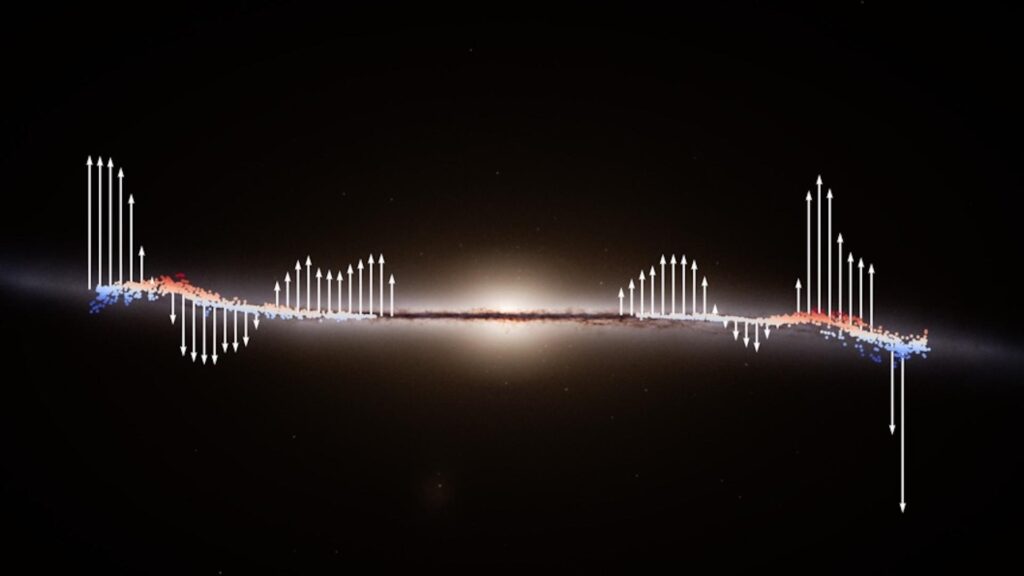A colossal gravitational disturbance, dubbed the “Great Wave,” is sweeping through our Milky Way galaxy, displacing thousands of stars from their usual orbits. Recent observations reveal this massive ripple is reshaping the stellar landscape on an unprecedented scale, challenging astronomers’ understanding of galactic dynamics. Scientists are now racing to unravel the origins and implications of this cosmic upheaval, which could shed new light on the complex forces shaping our galaxy’s evolution.
Great Wave Disturbing Stellar Orbits Across the Milky Way
Scientists studying stellar motion within the Milky Way have uncovered evidence of a massive wave-like disturbance sweeping through our galaxy, altering the orbits of thousands of stars. This phenomenal ripple, thought to be caused by gravitational interactions with a passing dwarf galaxy or dark matter subhalo, is pushing stars out of their usual paths, creating a dynamic celestial dance across the galactic disk. Advanced data from recent sky surveys have enabled astronomers to map this wave, offering new insights into the complex gravitational forces shaping our cosmic neighborhood.
Key observations highlighted include:
- Displacement Pattern: Stars exhibit vertical oscillations of up to 1,000 light-years from the galactic plane.
- Velocity Changes: Many stars are moving at unexpected speeds and directions, signaling past gravitational shocks.
- Galactic Impact: This disturbance influences star formation rates and could reshape star cluster distributions over millions of years.
| Parameter | Value | Effect |
|---|---|---|
| Amplitude (Ly) | ~1,000 | Maximum vertical displacement of stars |
| Wave Propagation Speed | ~300 km/s | Speed of stellar orbit disturbance |
| Duration | 100 million years | Estimated persistence of the wave pattern |
Unraveling the Origins and Impact of the Galactic Wave Phenomenon
The discovery of a massive oscillation moving through the Milky Way has sent shockwaves through the astronomical community. This galactic wave appears to be a force potent enough to displace thousands of stars from their customary orbits, reshaping the familiar stellar landscape. Scientists suggest that the phenomenon could stem from the gravitational aftermath of a past encounter with a dwarf galaxy or an unseen dark matter substructure, triggering a ripple effect across our galactic disk. Such disturbances challenge previous assumptions about the stability of our galaxy and offer fresh insights into its dynamic evolution.
Researchers are now tracking the velocity and trajectory of affected stars to chart the full scope of the wave’s impact. Observations indicate that the wave propagates at different speeds and intensities depending on radial distance from the galactic center, creating complex patterns of stellar motion. Early findings highlight key zones where star displacement peaks:
- Inner Disk – moderate star divergence, dense environment
- Solar Neighborhood – pronounced stellar shifts, significant perturbations
- Outer Rim – sparse star density, subtle wave effects
| Region | Estimated Star Displacement | Wave Speed (km/s) |
|---|---|---|
| Inner Disk | ~1,200 stars | 25 |
| Solar Neighborhood | ~3,400 stars | 35 |
| Outer Rim | ~800 stars | 15 |
Monitoring Star Displacement and Preparing for Future Cosmic Shifts
Astronomers are deploying a network of advanced telescopes and space observatories to track the subtle shifts in star positions caused by the galactic wave. This unprecedented movement affects thousands of stars, altering their trajectories and velocities. Monitoring these changes helps scientists understand the underlying forces at play and anticipate inevitable cosmic collisions or disruptions that could impact our solar system. Through precise measurements of star displacement, researchers can refine galactic models and predict how this “great wave” might reshape the structure of the Milky Way over the coming millennia.
Preparing for these future cosmic shifts involves a multifaceted approach:
- Continuous data collection: Using Gaia and other space missions to map star movements in real time.
- Simulation exercises: Running computer models to forecast mass star migrations and gravitational disturbances.
- Infrastructure readiness: Planning for potential impacts on satellite orbits and space exploration missions.
- International collaboration: Sharing findings across astrophysics communities worldwide to build a comprehensive response strategy.
| Star Cluster | Displacement Rate (ly/year) | Predicted Shift by 2100 |
|---|---|---|
| Perseus | 0.003 | 0.24 ly |
| Orion | 0.005 | 0.4 ly |
| Scorpius | 0.002 | 0.16 ly |
The Way Forward
As researchers continue to unravel the mysteries behind this vast stellar disturbance, the discovery of the “Great Wave” offers an unprecedented glimpse into the dynamic forces shaping our galaxy. These ripples not only challenge previous assumptions about the Milky Way’s stability but also open new avenues for understanding the complex gravitational interactions at play. With advanced telescopes and ongoing observations, scientists are poised to deepen our knowledge of how such cosmic waves influence the motion and evolution of stars-reminding us that even on a galactic scale, change is a constant force.
